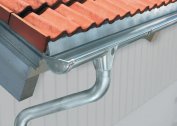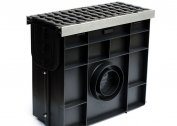A cesspool is an indispensable element of sewerage in country houses. Sometimes the owners have a problem associated with fast filling and poor outflow of water. If you do not find out in time the cause of the constant congestion of the cesspool, there is a risk of failure of the entire sewer system.
The main causes of poor water outflow
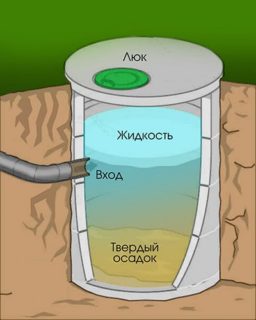 To identify the main causes of disruption of the cesspool, you need to know its structure well. Such a receiver is a reservoir of various sizes, which is built directly in the ground. Sometimes when it is constructed, a drainage bottom is made, which is filled with fine-grained gravel, river sand or broken brick.
To identify the main causes of disruption of the cesspool, you need to know its structure well. Such a receiver is a reservoir of various sizes, which is built directly in the ground. Sometimes when it is constructed, a drainage bottom is made, which is filled with fine-grained gravel, river sand or broken brick.
Such arrangement implies that all drains falling into the cesspool will be slowly absorbed into the ground through the walls and bottom. But over time, the drainage capacity of the reservoir decreases, water stagnates and a fetid odor appears nearby. The reason for this phenomenon may lie in the following.
- The appearance of a large layer of sludge at the bottom of the cesspool, which has grown due to the constant flow of feces. The resulting crust prevents liquids from absorbing.
- The appearance of a thick fat layer at the bottom of the drain tank. More often a combined problem arises, combining the formation of oily plaque and siltation.
- At low temperatures, the problem of poor absorption can be associated with severe freezing of the soil.
- Small cesspool. If too many people use the sewage system, additionally water from household appliances flows into it, the process of filling the tank is much faster.
Important! Sanitary regulations prohibit the construction of a cesspool on a site without sealed walls and a bottom. This design causes significant environmental damage. It is recommended that the tank be constructed in such a way that when it is filled, it is easy to pump out the accumulated liquid or dispose of it properly through the drainage.
Troubleshooting Methods
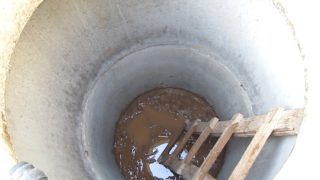 When choosing a method for eliminating problems with a cesspool, it is necessary to take into account the factor that provoked the stagnation.
When choosing a method for eliminating problems with a cesspool, it is necessary to take into account the factor that provoked the stagnation.
Fecal siltation
To remove the sludge, you need a sludge collector. With it, you first need to remove all sewage, after which the bottom is cleaned under high pressure with water. In addition, with large contamination, the crust is removed from the walls with brushes. After cleaning all surfaces, you will need to re-wash the receiver with high-pressure water.
If the crust is thick, special bacteria will need to be added to the water in order to clean it faster. But it is important to remember that they are active only in a humid environment at a positive air temperature.
Oily film removal
You can also remove plaque by flushing the system and using chemicals. The resulting fat is well corroded by bacteria, which turn it into compost and water. But since effluents often contain impurities of powders and other cleaning products, bacterial preparations cease to function. If no detergent components get into the drain, it is recommended to add bacteria such as Vodograi and Microbec to the receiver. In addition, they turn toilet paper into compost and accelerate the decomposition of food products.
If bacteria are powerless, nitrate oxidizing agents, formaldehydes and ammonium compounds should be used. After contact with fecal sludge and fat, it quickly reacts and dissolves the crusts. The safest for humans and nature are nitrate oxidizing agents.The mass formed after their use is allowed to be used as compost for plants. If the choice is made in the direction of ammonium, they should be used only in the warm season, otherwise there will be no result. Formaldehydes are allowed to be used only in emergency cases, since they practically destroy all plants within a radius of 10 meters.
Important! When using techniques and means against siltation and the formation of an oily film, it is also necessary to additionally clean the collector.
Freezing ground
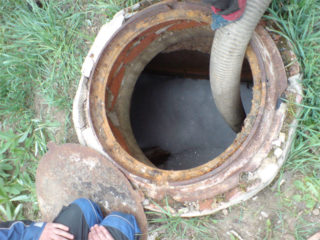 The elimination of this problem begins with the insulation of the pipeline. If it is not there, you should immediately warm up the pit itself. For this, several liters of boiling water are poured into it. After that, using a metal rod, it should be much higher in height than the tank itself, a small hole is made inside the drain directly through all the drained masses. An electric wire is thrown onto the rod and connected to the network. It is better to put a metal pin closer to the soil, and not in the center of the drain. It may take 1-2 days to warm up the receiver, taking into account its volume.
The elimination of this problem begins with the insulation of the pipeline. If it is not there, you should immediately warm up the pit itself. For this, several liters of boiling water are poured into it. After that, using a metal rod, it should be much higher in height than the tank itself, a small hole is made inside the drain directly through all the drained masses. An electric wire is thrown onto the rod and connected to the network. It is better to put a metal pin closer to the soil, and not in the center of the drain. It may take 1-2 days to warm up the receiver, taking into account its volume.
Inadequate receiver volume
If for some reason the existing tank size is no longer enough, you will need to increase it. This is done quite simply. It’s enough to dig another receiver nearby, which will connect to the first using a drain pipe. As soon as the level of the first cesspool is critical, all waste will go to the second compartment.
Preventive measures for clogging the cesspool
In order to prevent disruption of the cesspool and stagnation of water in it, it is enough to follow the recommendations to protect the drain from grease and siltation.
- It is required to pump out all sewage from the tank in a timely manner, while not allowing it. It is especially important to clean out the runoff before the onset of cold weather, if it is not planned to use it in the winter.
- Periodically flush the walls and bottom of the cesspool under high pressure. It is recommended to carry out such work at least once a year, but for the smooth functioning of the tank it is better to do this every six months.
- In the summer, special chemicals and bacteria should be poured directly into the drain, killing the unpleasant odor and eliminating the greasy film from the surface of the drain pit.
- Before starting the construction of the receiver, it is necessary to correctly calculate its volume and depth.
- It is impossible not to take into account the freezing point of the soil in a particular region.
- If winters are cold, you should consider warming the runoff.
If you follow all preventive measures and properly care for the cesspool, it will not cause any problems and will serve as much time as the owners need.
